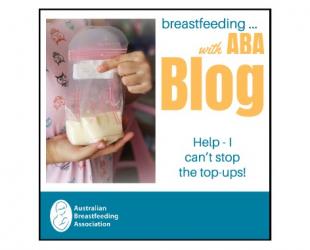Unsure about top-up feeds? This guide will help you decide what to do

It’s common to wonder if your baby needs extra milk. The good news is, most mums can make enough breastmilk and your supply responds to your baby’s feeding. If you’re concerned about low supply or top-ups, we’ll walk through how your body works and what can help.
In the early days after birth, your hormones turn on breastmilk production. After a few weeks, the amount of milk you make depends on how much is taken out. Your breasts are never truly “empty”. They’re always making milk. If milk isn’t removed, your body slows down and makes less.
If your supply is low, it’s often because your baby isn’t taking enough milk, not because you can’t make enough. Feeding more often and improving your baby’s latch usually helps
increase your supply.
Feeding from a bottle
When you give your baby a bottle, you might notice they drink a lot. This can make you think your baby is still hungry and that you’re not making enough milk. It’s easy to start believing you need to give top-ups. But there are reasons why babies often drink a lot from a bottle:
- Babies have a strong sucking instinct and may drink even if they’re full.
- Bottles usually flow faster, so babies drink quickly to keep up, not because they’re hungry.
- It’s easier for babies to get milk from a bottle than the breast because they don’t have to work as hard
You can’t judge your breastmilk supply by how much your baby takes from a top-up feed. Regular extra formula can reduce your supply.
Do I need to top up?
There are many reasons mums think they have low supply. Here’s how to know if your baby is getting enough:
- At least 5 heavily wet disposable nappies or 6 very wet cloth nappies in 24 hours
- Soft poos
- Good skin tone and bright eyes
- Generally content, even if sometimes fussy
- Gaining weight and growing
If your baby shows these signs, your supply is fine, even if:
- your breasts feel softer
- your baby feeds more often or for shorter times
- you stop feeling a let-down
- your baby has fussy days or poos less often as they get older
- weight gain slows after the first few months
How can I top up and protect my supply?
Start by trying these steps:
- Feed more often in 24 hours.
- Offer each breast more than once per feed.
- Improve your baby’s attachment.
- Use breast compressions during feeds to help your milk flow.
If your baby needs a top-up:
Express between feeds so you can use your own milk.
Give top-up feeds with a small cup, paced bottle feeding or a supply line at the breast.
Offer only small top-ups, just enough to keep baby satisfied until the next breastfeed.
Most mums can increase their supply with the right information and support. Talk with an ABA breastfeeding counsellor to make a plan for building your supply and reducing top-ups.
© Australian Breastfeeding Association December 2025


